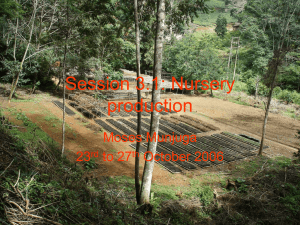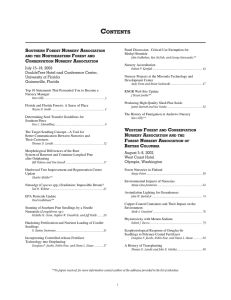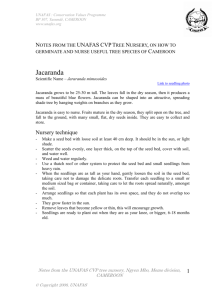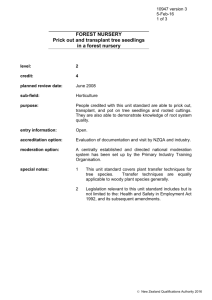A H T D. L
advertisement
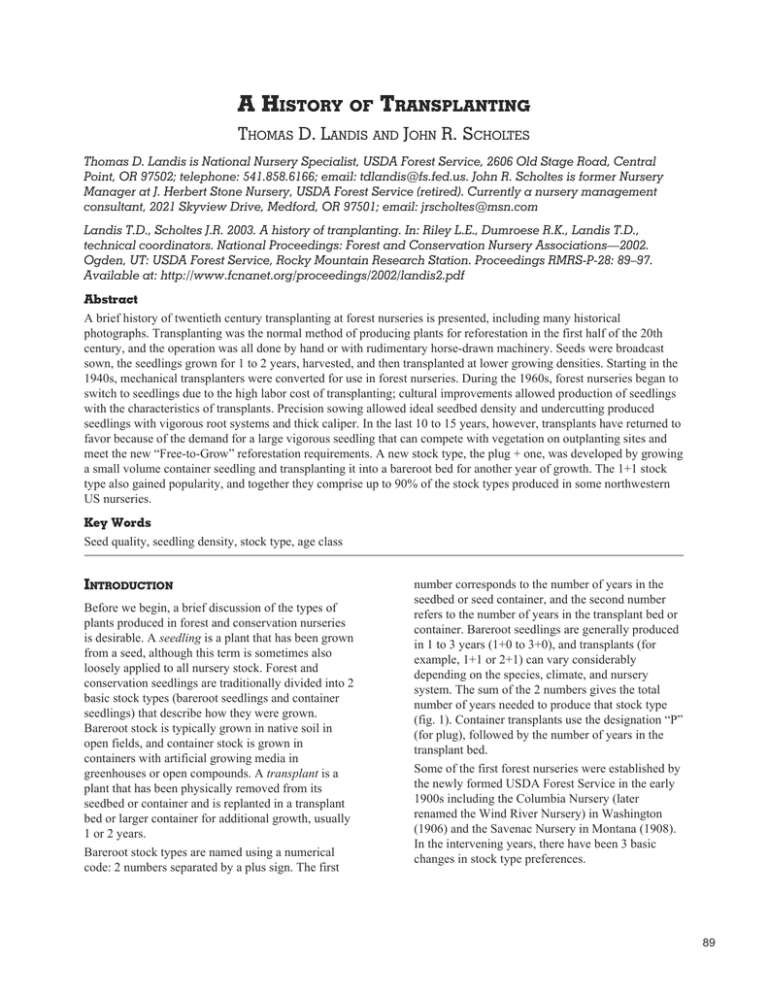
A HISTORY OF TRANSPLANTING THOMAS D. LANDIS AND JOHN R. SCHOLTES Thomas D. Landis is National Nursery Specialist, USDA Forest Service, 2606 Old Stage Road, Central Point, OR 97502; telephone: 541.858.6166; email: tdlandis@fs.fed.us. John R. Scholtes is former Nursery Manager at J. Herbert Stone Nursery, USDA Forest Service (retired). Currently a nursery management consultant, 2021 Skyview Drive, Medford, OR 97501; email: jrscholtes@msn.com Landis T.D., Scholtes J.R. 2003. A history of tranplanting. In: Riley L.E., Dumroese R.K., Landis T.D., technical coordinators. National Proceedings: Forest and Conservation Nursery Associations—2002. Ogden, UT: USDA Forest Service, Rocky Mountain Research Station. Proceedings RMRS-P-28: 89–97. Available at: http://www.fcnanet.org/proceedings/2002/landis2.pdf Abstract A brief history of twentieth century transplanting at forest nurseries is presented, including many historical photographs. Transplanting was the normal method of producing plants for reforestation in the first half of the 20th century, and the operation was all done by hand or with rudimentary horse-drawn machinery. Seeds were broadcast sown, the seedlings grown for 1 to 2 years, harvested, and then transplanted at lower growing densities. Starting in the 1940s, mechanical transplanters were converted for use in forest nurseries. During the 1960s, forest nurseries began to switch to seedlings due to the high labor cost of transplanting; cultural improvements allowed production of seedlings with the characteristics of transplants. Precision sowing allowed ideal seedbed density and undercutting produced seedlings with vigorous root systems and thick caliper. In the last 10 to 15 years, however, transplants have returned to favor because of the demand for a large vigorous seedling that can compete with vegetation on outplanting sites and meet the new “Free-to-Grow” reforestation requirements. A new stock type, the plug + one, was developed by growing a small volume container seedling and transplanting it into a bareroot bed for another year of growth. The 1+1 stock type also gained popularity, and together they comprise up to 90% of the stock types produced in some northwestern US nurseries. Key Words Seed quality, seedling density, stock type, age class INTRODUCTION Before we begin, a brief discussion of the types of plants produced in forest and conservation nurseries is desirable. A seedling is a plant that has been grown from a seed, although this term is sometimes also loosely applied to all nursery stock. Forest and conservation seedlings are traditionally divided into 2 basic stock types (bareroot seedlings and container seedlings) that describe how they were grown. Bareroot stock is typically grown in native soil in open fields, and container stock is grown in containers with artificial growing media in greenhouses or open compounds. A transplant is a plant that has been physically removed from its seedbed or container and is replanted in a transplant bed or larger container for additional growth, usually 1 or 2 years. Bareroot stock types are named using a numerical code: 2 numbers separated by a plus sign. The first number corresponds to the number of years in the seedbed or seed container, and the second number refers to the number of years in the transplant bed or container. Bareroot seedlings are generally produced in 1 to 3 years (1+0 to 3+0), and transplants (for example, 1+1 or 2+1) can vary considerably depending on the species, climate, and nursery system. The sum of the 2 numbers gives the total number of years needed to produce that stock type (fig. 1). Container transplants use the designation “P” (for plug), followed by the number of years in the transplant bed. Some of the first forest nurseries were established by the newly formed USDA Forest Service in the early 1900s including the Columbia Nursery (later renamed the Wind River Nursery) in Washington (1906) and the Savenac Nursery in Montana (1908). In the intervening years, there have been 3 basic changes in stock type preferences. 89 Figure 1. In the first half of the 20th century, transplant stock types (2+2, 3+1 and 3+2) were preferred over seedlings (3+0, 5+0) because transplants have more fibrous roots systems and better shoot-to-root ratios (Tillotson 1917). 1900 TO 1965: TRANSPLANTS ARE PREFERRED During the early days of forest nursery production in North America, the use of transplanted seedlings was the norm. Transplant stock types had much better root systems and stem diameter (“caliper”) than seedlings (fig. 1), and so were preferred by foresters even though they were much more expensive. The average cost of transplants at $4.25 per thousand was over 7 times that of seedlings at $0.60 per thousand (Toumey 1916). In fact, most nursery manuals didn’t even discuss the use of seedlings except as a prelude to transplanting (for example, Yerkes 1929). These stock preferences were backed-up by research trials that proved the superiority of transplants (table 1). The nursery production cycle started with broadcast sowing of seed and then culturing the seedlings for Table 1. Results of outplanting trials with different stock types of ponderosa pine in 1915 on the Shasta National Forest in northern California. Stock Type 1+0 2+0 1+1 2+1 1+2 1+1+1 Modified from Show (1930) 90 Outplanting Survival (%) 31 6 82 92 78 99 the remainder of the growing season. If the seedlings were not large enough, they could be held in the seedbeds for another year or two. Once they reached acceptable size, seedlings were harvested in the spring, processed, and immediately transplanted (fig. 2). The transplants were then grown for another year or two until they were sufficiently large for outplanting. In some nurseries, 1+1 transplants were transplanted for another year to produce a 1+1+1 stock type (table 1). In these early years, the quality of American grown seedlings was pretty marginal. In fact, late in the 19th century, a number of American foresters, including Gifford Pinchot, sent local seed to European nurseries to have plants grown and shipped back for outplanting. Of course, some of this may have been a trendy method of pleasing distinguished clients such as the Vanderbilt Estate, but there were some understandable reasons for poor seedling quality in American nurseries. Initial Problems with Seedling Quality Seed Collection—Even though there was a good understanding of the basic nature of conifer seed in the early 20th century, cone collection practices did not produce high quality seed for the nurseries to sow. One source states “When squirrels begin to cut off cones for storing, collecting should begin at once” (Tillotson 1917). From another source, Figure 2. In the first half of the 20th century, seedlings were grown for 1 to 3 years, harvested, transplanted by hand, and then cultured for another 1 or 2 years. “Furthermore, squirrels hoard only the best cones” (Toumey 1916). Seed Processing—Seed cleaning operations, such as wing removal, lacked the machinery and finesse of today’s operations. Some quotes from an early nursery manual are revealing. “Another process is to pile the seed 6 to 8 inches deep on a cement or plank floor, sprinkle it lightly with water, and then beat it energetically with leather flails.” “Sometimes the sacks are trampled underfoot for a few moments but this impairs the quality of the seed” (Tillotson 1917). The results would explain why some nursery seedlings did not get off to the best start. After using a grain grading machine (presumably a fan mill), one nursery reported germination test results for yellow pine (Pinus ponderosa) seed after 45 days as being 13.5% for the heaviest class, 1% for class 2 and 0.5% for class 3. They didn’t test class 4, since it was mostly debris and broken seed (Tillotson 1917). In another nursery manual, the germinative capacity of ponderosa pine from 3 sources averaged 37.0%, 61.9%, and 44.6% (Toumey 1916). By today’s standards, none of these seeds would be acceptable for anything but the trash can. High Sowing Density—Another problem was the belief that high growing densities yielded the best seedlings (fig. 3). Two publications of the day support the practice of very high seedbed densities. “The young plants often do best when growing in rather dense stands of 75 to 150 per square foot” (807 to 1614/m2)(Yerkes 1929). “In general, coniferous seed should be sown in sufficient quantity to produce from 50 to 200 seedlings per square foot” (538 to 2152/m2)(Toumey 1916). The reason for these high sowing densities was probably frost heaving and other environmental factors. Figure 3. Early nursery managers had the mistaken belief that seedbeds should be densely sown (~ 100/ft2 [1076/m2]) to produce the best quality seedlings (modifed from Stoeckeler and Slabaugh 1965). 91 Nursery location, facilities, and cultural factors— Lack of roads and transportation dictated that nurseries be located close to the larger outplanting operations. As a result, these nurseries were often in climates and soils that were marginal at best. In addition, nursery cultural practices such as irrigation and fertilization were rudimentary by today’s standards (fig. 4). Considering all these factors, it is no wonder that the seedlings from early forest nurseries were not of the highest quality. 1965 TO 1985: CHANGE TO SEEDLINGS The second phase in the history of transplanting began when high labor costs made transplanting too expensive, and new nursery equipment made it possible to produce a seedling with the physical characteristics of a transplant. In addition, advances in seed collection and processing produced seed with high germination rates which was then sown with new precision seed drills. Nursery managers realized that lowering seedbed densities to an average of 20 to 2 2 25 seedlings/ft (215 to 270/m ) produced seedlings with more stem caliper and fewer culls. Great advances were made with undercutting machinery. The New Zealand Root Pruner featured a thin, serrated blade which oscillated back and forth to precisely cut seedling roots (fig. 5). These new root culturing procedures of undercutting and wrenching produced seedlings with dense fibrous root systems that were previously only available with transplants (Van Dorrser and Rook 1972.). To confirm their quality, outplanting trials of root cultured 2+0 seedlings showed good survival and growth. This trend to seedling production was reflected in contemporary nursery manuals. For example, Reforestation Practices for Conifers in California has an entire section on nursery production, but transplanting is not even discussed as a cultural practice (Schubert and Adams 1971). Some bareroot transplants were still produced during this time period, primarily 1+1s and 2+1s, which were used on difficult outplanting sites (table 2). In particular, transplants were popular for sites with dense brush competition and severe animal browsing. A new stock type, the container transplant, was invented during this period, and the “plug + 1 (P+1)” would soon gain wide acceptance with foresters and other seedling customers. The P+1 was first produced at the Ray Leach Nursery in Aurora, Oregon, in 1971, but the real promoter of this new stock type was Phil Hahn at the Georgia-Pacific container nursery in Cottage Grove, Oregon. Originally conceived as a way to hold over container A B Figure 4. Early fertilization consisted of applying a liquid manure slurry to the seedbeds. 92 Figure 5 A/B. The New Zealand root pruner (A) featured a thin oscillating blade (B) which precisely prunes roots and produces a seedling with transplant characteristics. seedlings in bareroot beds, Phil continued to experiment with cultural regimes and scheduling (Hahn 1984). Outplanting trials were very encouraging and soon other nurseries began to follow suit. The Plug + 1 has continued to grow in popularity and is one of the reasons for the resurgence in the popularity of transplants in recent years. larger stock types. Seedling customers felt that plants with large, fibrous root systems, thick stem caliper, and shoots with more lateral branching had a better chance of surviving and growing on these tougher outplanting sites. “Free-to-Grow” Reforestation Requirements 1990 TO PRESENT: THE RETURN TO TRANSPLANTS The Pacific Northwest states passed new forestry legislation that required all plantations be above the height of the competing vegetation within a relatively short time, typically 5 years. This meant that, instead of just surviving, outplanted stock had to grow rapidly; large transplants had an initial height advantage over smaller seedlings. In the past 10 to 15 years, transplant stock types have been regaining their popularity with nursery customers in the Pacific Northwest. Stock production statistics from the Washington Department of Natural Resources Webster Nursery are illustrative. In 1987, the 2+0 seedling was by far the most popular stock type, with transplants accounting for only 10% of total production. Seedlings had lost their majority by 1997 and, 5 years later, the trend had completely reversed with transplants being the favored stock type (table 3). There are several reasons for this recent change in planting stock preference (Landis 1998). TRANSPLANTING METHODS Currently, all transplanting is done by machine, and the equipment and techniques are discussed in detail in the other papers in this Proceedings. The 1+1 is the most common bareroot transplant, and plug+1s continue to increase in popularity. Container-tocontainer transplants are a relatively new innovation and are rapidly gaining acceptance by nursery managers and their customers. Transplanting equipment and techniques have also undergone some interesting changes during the last century. Plant Competition and Animal Browsing Legal restrictions on the use of site preparation herbicides and increasing problems with deer and elk predation helped fuel the demand for larger and Table 2. Stock types used for reforestation in the Lake States. Species Balsam fir Eastern hemlock Jack pine Red pine White pine White spruce Easy to Average Outplanting Sites 2+2, 3+0, 4+0 2+2 2+0, 11⁄2 + 0, 1+0 2+1, 3+0, 2+0 3+0, 2+0, 2+1 2+2 Difficult Outplanting Sites 2+2, 2+3, 3+2 2+2, 2+3 1+1, 2+0 2+2, 1+2, 2+1 2+2, 1+2 2+2, 2+3, 3+2 Source: Stoeckeler and Jones 1957 Table 3. Stock type trends at the Webster Forest Nursery, Olympia, WA. Stock Type 2+0 Seedlings Transplants: 1+1 and P +1 1987 90% 10% 1997 48% 52% 1992 10% 90% Source: Ramirez 2002 93 Table 4. Comparison of transplanting production efficiency using different methods. Transplanting Method Persons/Crew Transplant Boards (see fig. 2) 20 Transplant Boards & Lining-Out Plow (see fig. 6) 15 Self-propelled 2-row Transplanter (see fig.7) 2.5 7-Row Transplanter with Tractor (see fig. 8) 9 Hand Transplanting Initially, all seedlings were transplanted by hand and there were 2 basic techniques (Toumey 1916). Hole or “Dibble” Transplanting—Using a notched board as a spacing template, holes were dug at regular intervals with a hand trowel, dibble, or planting hammer and the seedlings planted one by one. The workers moved backwards down the bed, keeping each line of transplants parallel to the last. Transplant Boards—The next innovation in hand transplanting was the transplant board, and there were several variations (Stoeckeler and Jones 1957; Stoeckeler and Slabaugh 1965). Each involved trimming the roots of the harvested seedlings and “threading” them side by side into regularly-spaced notches in the transplant board. Originally, threading was done in the open fields, but progressive nursery managers soon erected tents (“coops”) to house the threaders and keep the seedlings out of the direct sun. The next step in the process was to open a furrow with a hand trencher that was deep enough so that the seedling roots could be oriented vertically against the cut face (fig. 2). Another worker covered the roots with soil up to the seedling root collar to complete the process. At Bessey Nursery in Nebraska, a 20person crew was used (10 threaders, 5 planters, 3 trenchers, 1 seedling carrier, and 1 foreman), and this crew could transplant 150,000 to 175,000 seedlings per day (table 4). The next improvement in the hand transplanting process was to use a plow drawn by a horse to open the furrow. Once the furrow was opened, crews used transplant boards to situate the seedlings against the cut surface. As before, another crew member tamped soil against the seedlings to finish the process. When hand trenchers were used, rows of transplants were oriented across the bed (fig. 2) but, with the advent of the plow, long rows were made parallel to each other (fig. 6). In one nursery, 5 rows of transplants were oriented 9 inches (22 cm) apart to produce a transplant bed 36 inches (90 cm) wide, with an 18 inch (45 cm) alley between each bed to allow for 94 Rate/Person/Hr 1016 1250 1500 1875 Source Stoeckeler and Slabaugh 1965 Aldhous 1975 Stoeckeler and Jones 1957 Hanks 1962 tractor cultivation (Aldhous 1975). A crew of 15 could transplant 8000 to 12,000 seedlings per day (table 4). This process became known as “lining-out” and this term is still used instead of “transplanting” in most ornamental and horticultural nurseries. Hand transplanting required a large crew, which was not a problem in the first half of the 20th century; government nurseries used cheap labor from work programs such as the Civilian Conservation Corps. In the 1940s and 1950s, however, the increasing cost of hand labor was becoming excessive and so more mechanization was utilized (Hanks 1962). By the Figure 6. A “lining-out plow” was modified to increase the efficiency of transplanting with transplant boards, and the rows ran the length of the bed (modified from Aldhous 1975). mid 1950s, one nursery manual stated that hand transplanting had almost disappeared (Stoeckeler and Jones 1957). At the current time, hand transplanting is only used for very small numbers of transplants, or in smaller nurseries that cannot afford to purchase transplanting machines. Machine Transplanting The first machine transplanter was developed by the Holland Transplanter Company in Holland, Michigan, for transplanting celery in 1927. By 1940, these transplanters had been modified with a deeper planting shoe for use with pine seedlings in a Michigan nursery. This first trial proved the feasibility of machine transplanting in forest nurseries and found that transplanting costs could be cut in half, compared to transplant boards (Hildebrand 1943). The 2-row Holland transplanter was self-propelled with a gasoline engine and contained 2 planting units (fig. 7). Each unit consisted of a coulter and shoe that opened a furrow. A worker placed seedlings into the pockets of a revolving disk that was situated between the 2 packing wheels. As the disk revolved, the seedlings were released upright in the furrow that was immediately closed by the packing wheels. The tongue on the front of the machine supported the engine, and also contained a steering shoe. At the end of the bed, the transplanter would be rotated and realigned for another pass (fig. 7). Running the transplanters back and forth along the beds would produce beds of 10 rows that were spaced 9 inches (23 cm) apart (Hildebrand 1943). These 2-row machines were able to plant seedlings at a rate of 11 to 14 ft/min (3.4 to 4.3 m/min), which translated to 30,000 seedlings in an 8-hour day (Stoeckeler and Jones 1957). In the 1940s and 1950s, more modifications were made to machine transplanters to allow all rows in the bed to be planted at once. This innovation also resulted in a standard bed width that could be straddled by the tractor and equipment. The Bradley transplanter was a 5-row machine pulled by a remodeled tractor that was geared down to the relatively slow speeds necessary for best operation of the planting wheels. Since all the rows were evenly spaced, the beds could be cultivated with other equipment (Slavin and Locke 1949). A 6-row transplanter with a deeper shoe was the next improvement (Landquist 1959) and, by this time, newer tractors with slower speeds were commercially available (fig. 8). In 1961, the Bessey Nursery in Nebraska developed a 7-row transplanter (Hanks 1962) that had an average production of 135,000 seedlings per day (table 4). Most transplanters are modifications of commercial units and can transplant 6 to 8 rows per bed, depending on the species and target seedling specifications. Figure 7. One of the first machine transplanters that was modified for tree nurseries was self-propelled and transplanted two rows at once. 95 Figure 8. By the 1960s, full-bed transplanting machines could plant 6 to 8 rows at one time. These units were the progenitors of modern transplanters (modified from Aldhous 1975). SUMMARY In the first half of the 20th century, transplants were the preferred stock type because seed and seedling quality was marginal. Hand transplanting was the most common technique because of cheap labor. Starting around 1940, machine transplanting became the rule due to the rising cost of labor and the modification of existing agricultural equipment. Seedlings began to replace transplants as the desired stock type in the 1960s to 1980s because new root culturing and precision sowing techniques produced seedlings with the fibrous roots and stem diameters of transplants. In recent years, transplant stock types, especially 1+1s and plug+1s, regained popularity in the Pacific Northwest due to the need for larger plants to meet new outplanting challenges. REFERENCES Alhous JR. 1975. Nursery practice. London: Her Majesty’s Stationery Office. Forestry Commission Bulletin No. 43. 184 p. 96 Hahn PF. 1984. Plug + 1 seedling production. In: Duryea ML, Landis TD, editors. Forest nursery manual: production of bareroot seedlings. The Hague/Boston/Lancaster : Martinus Nijhoff/Dr W. Junk Publishers, for Forest Research Laboratory, Oregon State University, Corvallis. p 165-181. Hanks SH. 1962. A seven-row seedling transplanter for nursery use. Tree Planters’ Notes 53:20-22. Hildebrand WH. 1943. A machine for transplanting seedlings. Journal of Forestry 41(7):476-479. Landis TD. 1998. Forest and conservation nursery trends in the Northwestern United States. IN: Kooistra CM, technical coordinator. Proceedings of the 1995, 1996 and 1997 Annual Meetings of the Forest Nursery Association of British Columbia. p 144-146. Landquist KB. 1959. The Holland Transplanter, further modifications of the shoe to improve root position. Tree Planters’ Notes 38:11. Ramirez T. 2002. Personal communication. Olympia (WA): Nursery Manager, Webster State Forest Nursery, Washington Department of Natural Resources. Schubert GH, Adams RS. 1971. Reforestation practices for conifers in California. Sacramento (CA): State of California, Division of Forestry. 359 p. Show SB. 1930. Forest nursery and planting practices in the California pine region. Washington, (DC): USDA Forest Service. Circular No. 92. 75 p. Slavin AD, Locke SS. 1949. The new Bradley transplanter. Journal of Forestry 47(7):531-532. Stoeckeler J H, Jones GW. 1957. Forest Nursery Practice in the Lake States. Washington (DC): United States Department of Agriculture. Agriculture Handbook No. 110. 124 p. Stoeckeler JH, Slabaugh PE. 1965. Conifer nursery practice in the prairie-plains. USDA Agriculture Handbook 279. 93 p. Tillotson CR. 1917. Nursery practice on the National Forests. USDA Agricultural Bulletin 479. 86 p. Toumey JW. 1916. Seeding and planting in the practice of forestry. 3rd ed. New York (NY): John Wiley & Sons Inc. 455 p. Van Dorrser JC, Rook DA. 1972. Conditioning of radiata pine seedlings by undercutting and wrenching: description of methods, equipment, and seedling response. New Zealand Journal of Forestry 171:61-73. Yerkes GE. 1929. Propagation of trees and shrubs. Washington (DC): US Department of Agriculture Farmers’ Bulletin No. 1567. 97

